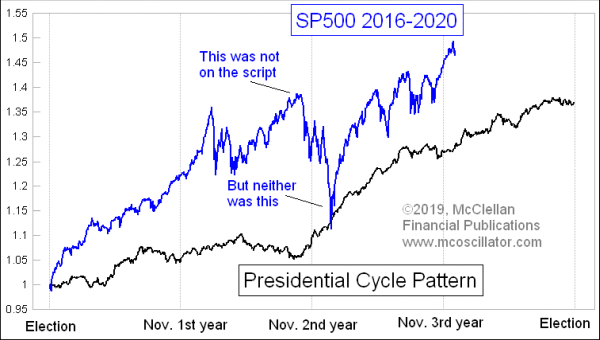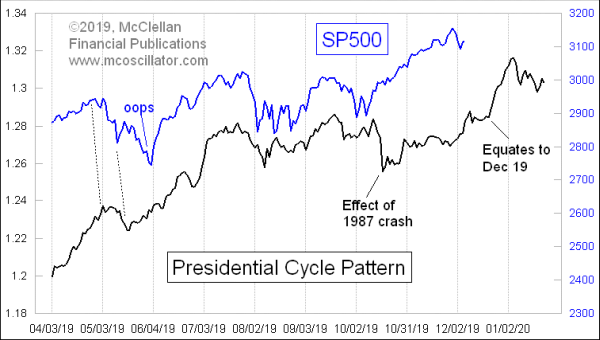
Now that we are less than 12 months from the next presidential election, it is appropriate to talk about how the stock market typically behaves during an election year. The short answer is that election years are up, on average, although not as strongly as the 3rd year of a presidential term. When an election year does see a down stock market, as in 2000 or 2008, it is bad for the party in power.
This week's chart shows our Presidential Cycle Pattern, which is an average of the S&P 500's behavior over the 4 years of each presidential term. I'm choosing to use a different definition of "year" than the normal calendar year starting on January 1. I instead employ a count which starts each year on Nov. 1, to better align with the timing of the presidential election. I have found that the stock market starts reacting to whoever gets elected almost immediately, rather than waiting for the Jan. 20 inauguration.
Generally speaking, the stock market goes sideways during the first two years of a president's term in office. This is especially true in the first term of a new president. When a new president takes office, he typically spends the first 2 years "discovering" that things are even worse than he told us during the campaign, and that the "only solution" is whatever package of tax hikes/cuts and/or spending increases he hopes to get approved by Congress. Investors tend to get bummed out by hearing that conditions are worse than they thought, and so they are not in a mood to bid up stock prices.
Then after the mid-term elections, the new president typically spends the final two years of the term declaring victory for having fixed everything, and running for reelection. Investors respond by feeling better about hearing that everything is better now, and they tend to bid up the stock market during the 3rd year. Election years are iffier, because they hold the risk that we all might have to get used to some new President taking office, and so election years are still mostly positive, but not as much as 3rd years.
When President Trump won the election in November 2016, the stock market initially had a negative reaction, with S&P 500 futures getting locked limit down (5%) overnight, but then rallied strongly the next day and beyond. Curiously, though, the pattern of the S&P 500 during President Trump's first 2 years did not correlate very well at all to the Presidential Cycle Pattern (PCP). Everyone seems to agree that President Trump is a "different sort of president," which might be the explanation for the curious lack of correlation.
Then, starting after the spike bottom on Dec. 24, 2018, the S&P 500 started correlating really tightly with the PCP, as if a switch had been flipped and prices got locked into what the script says. Maybe President Trump is becoming more of a "normal" type of president now. Naahhh, that can't be it.
This next chart zooms in closer on just the immediate relationship between the S&P 500 and the PCP:

This allows us to see that, even as the correlation between the two has tightened up a lot, there are still moments when prices get off track from what the script says. Sometimes that makes sense, as a news item moves prices in a way that is different from the historical record. Other times are problems with the PCP, such as in mid-October, when the PCP shows a big downward skew courtesy of the effects of the October 1987 crash on the average price data.
We are now in December, which has a record of being a really strong month in terms of seasonality. That is true also in the year before the election, although it is important to note that December's strength tends to be concentrated in the last half of the month. The first half of December sees a pause/correction, which is what we appear to be going through now.
Such pauses are healthy and helpful to the sustaining of an uptrend. They set everyone to muttering about how the bull market is over, prices are going down, the sky is falling and we're all going to die I TELL YOU!! Once that is accomplished, prices can start higher again; currently, they should start higher going into January, assuming that the S&P 500 continues to follow the average pattern shown in the PCP.
